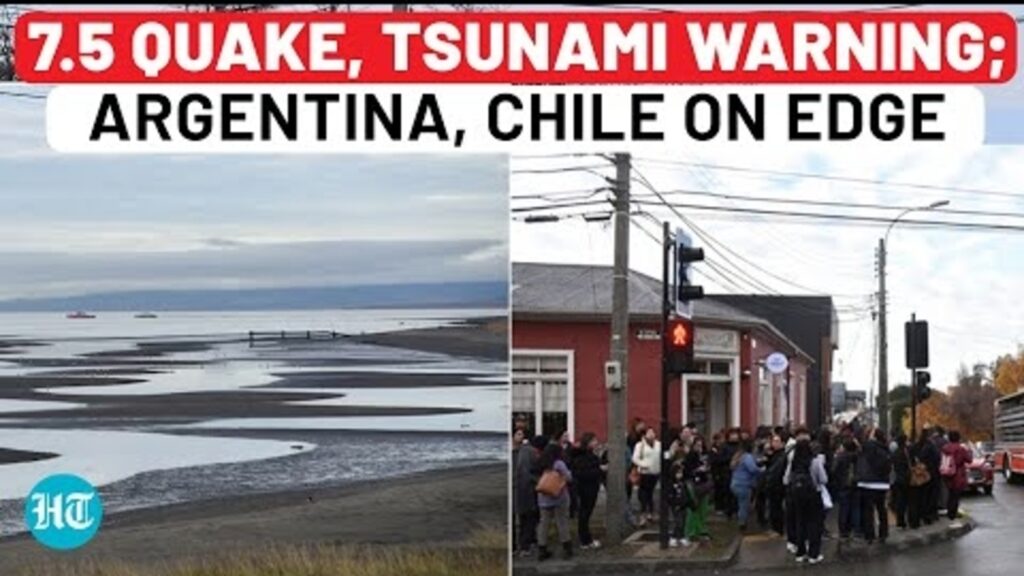
SANTIAGO, Chile / BUENOS AIRES, Argentina — May 3, 2025
A powerful 8.3-magnitude earthquake struck off the southern coast of Chile early Tuesday morning, prompting widespread tsunami warnings and triggering large-scale evacuations across coastal areas of both Chile and neighboring Argentina. Authorities credit early warning systems and emergency protocols for the absence of reported fatalities, though damage assessments are ongoing.
Earthquake and Tsunami Alert
The quake occurred at approximately 3:46 a.m. local time, with its epicenter located roughly 120 kilometers west of the Chilean coast near Puerto Saavedra. The Chilean National Seismological Center immediately issued a red-level tsunami warning, prompting the evacuation of thousands of residents from low-lying coastal regions.
According to the Chilean Navy’s Hydrographic and Oceanographic Service (SHOA), initial tsunami waves measuring up to 2.5 meters struck parts of the Araucanía and Los Ríos regions within an hour of the quake. Minor inundation was reported in towns including Toltén, Queule, and Corral, where dockside businesses and fisheries suffered moderate damage.
Evacuations Across Borders
In Argentina, the National Emergency System (SIFEM) issued precautionary evacuation advisories for lakeside communities in Patagonia, including San Carlos de Bariloche and Villa La Angostura, fearing potential secondary effects via connected waterways and rivers. Local officials also temporarily closed schools and suspended boat traffic on Lake Nahuel Huapi.
“We coordinated with Chilean authorities and issued alerts in real time,” said Paula Fernández, head of Civil Protection in Argentina’s Río Negro Province. “While the direct tsunami impact was unlikely here, we took no risks, especially with residents and tourists near lakes and rivers.”
Emergency Response and Community Impact
Chile’s Ministry of the Interior confirmed that over 25,000 residents were evacuated in less than two hours, many of them relocating to pre-designated safe zones and elevated shelters. Emergency drills practiced in recent years were credited with improving evacuation times and community coordination.
María Torres, a schoolteacher in Puerto Saavedra, described the experience: “We heard the sirens and just moved. Everyone knew what to do—it was frightening, but also deeply reassuring to see people helping one another.”
Though there were no confirmed deaths or serious injuries, Chilean President Isabel Rodríguez addressed the nation by midday, praising the quick action of local officials and first responders. “This was a test of our preparedness, and I am proud of how our communities responded,” she said in a televised statement. “We will provide full support to those affected and begin reconstruction immediately.”
Infrastructure and Economic Impact
Preliminary assessments suggest that fishing infrastructure, market stalls, and coastal roads bore the brunt of the tsunami’s force. In Toltén and Mehuín, docks were partially submerged, and several fishing boats were carried inland. Power outages affected more than 8,000 homes, though most services were restored by the evening.
Chile’s Finance Ministry announced a provisional emergency fund of $45 million pesos (approx. USD 50 million) to assist affected regions. Argentina’s government also dispatched humanitarian aid and technical teams to border towns for cross-coordination.
Moving Forward
Both countries have vowed to review and strengthen their earthquake and tsunami response systems. International seismology experts noted that the quake originated in one of the most seismically active zones on Earth—the so-called “Ring of Fire”—where tectonic plates frequently shift with destructive results.
“This event is a reminder of the region’s vulnerability, but also its resilience,” said Dr. Andrés Pizarro, a geophysicist at the University of Santiago. “The cooperation between Chile and Argentina was notable and should serve as a model for future disaster response.”
As night fell, thousands remained in shelters, awaiting official clearance to return home. Despite damage and disruption, a cautious sense of relief settled over the region, buoyed by the knowledge that the disaster could have been far worse.






